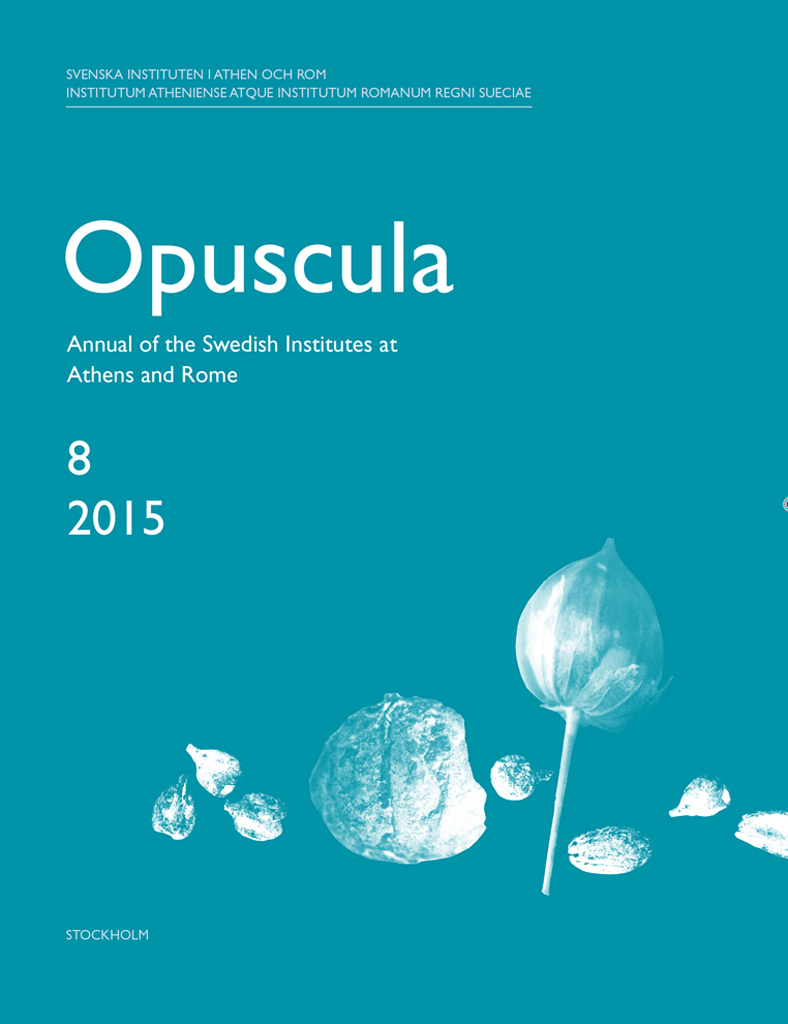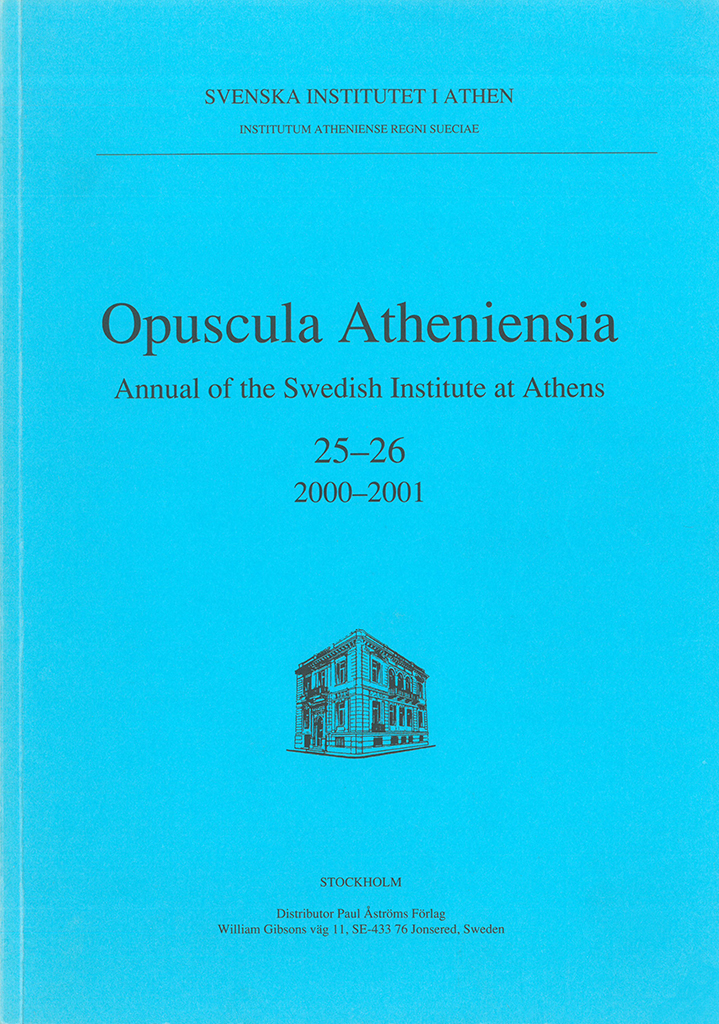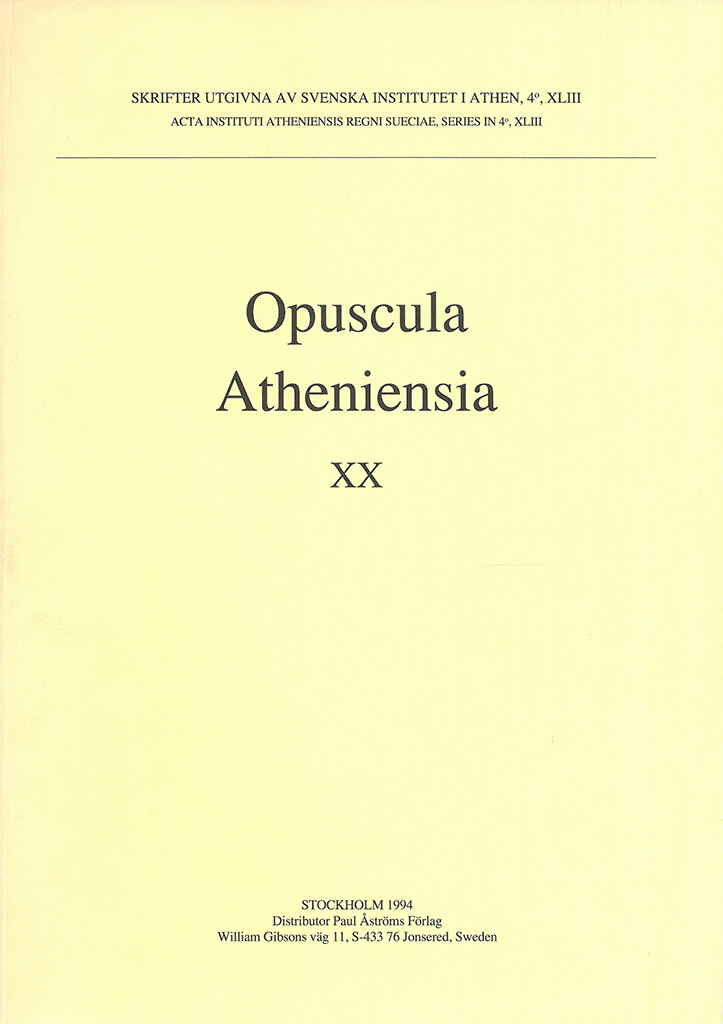Opuscula 14 is published with open access. Printed edition distributed by Eddy.se AB. Also available at Amazon.com, Adlibris, and Bokus. View volume at ERIH PLUS. Palaepaphos-Teratsoudhia Tomb 288 (c. 1650 BC–c. 1200 BC) By Vassos Karageorghis (University of Cyprus) & Efstathios Raptou (Department of Antiquities, Cyprus), with appendices by Alexander Donald, Gisèle Clerc & Anna Spyrou Abstract This paper presents a new tomb complex of the Late Bronze Age at Palaepaphos-Teratsoudhia in south-west Cyprus. Although looted, Tomb 288 yielded a representative repertoire of funerary gifts, including seals and scarabs, ranging chronologically from the very beginning of the Late Bronze Age to Late Cypriote IIC, roughly from 1650 to 1200 BC. Tomb 288 has characteristics which are typical of Late Bronze Age tomb architecture in Cyprus and well known in the Paphos region, as well as aspects which have not previously been observed in any necropolis of the period, such as the large central “pillars” which support the roof in Chambers A and B. The tomb’s finds comprise representative examples of the ceramic production of Palaepaphos for a period of some 400 years and illustrate the wealth of this region during the whole of the Late Bronze Age. The tomb is…
All content of Opuscula 12 (2019) is available with open access. Printed edition distributed by Eddy.se AB. Also available at Amazon.com, Adlibris, and Bokus. View volume at ERIH PLUS. Palaepaphos-Skales Tomb 277. More prestigious burials. With an appendix by Maria A. Socratous By Vassos Karageorghis (The Cyprus Institute, Cyprus) & Efstathios Raptou (Cyprus Museum, Cyprus) Abstract Tomb 277 in the Skales cemetery at Palaepaphos, excavated by the Cyprus Department of Antiquities, is among the richest ever found in the south-west of the island. It dates to the Cypro-Geometric III period (c. 900–750 BC) and was used for multiple burials of important members of the Palaepaphian society, namely warriors and important women (priestesses of the Great Goddess?) judging from the abundant offerings of arms and armour as well as gold jewellery respectively (including gold plaques embossed with the head of the Egyptian goddess Hathor). Notable among the offerings are two bronze basins, six small hemispherical bronze bowls, two bronze mace-heads (symbols of authority), a bronze shield of a rare type, and two richly decorated belts of oriental type. We also mention two iron swords and a bronze spearhead. Among the pottery we note the high percentage of Phoenician imports. Both inhumations…
Opuscula 8 (2015) is now available for purchase and free download at Bokorder.se. Also available at Amazon.com, Bokus.com and Adlibris.com. Two new Proto-White Painted ware vases of the pictorial style from Palaepaphos, Cyprus By Vassos Karageorghis & Efstathios Raptou Abstract The publication of two Proto-White Painted ware pictorial style vases found at the necropolis of Palaepaphos-Skales in Cyprus is preceded by a discussion of several issues relating to this style which appeared early in the 11th century BC. In recent years scholars have expressed conflicting views about the origin of the silhouetted pictorial motifs (birds, quadrupeds, human figures etc.), which appear next to the linear geometric decoration on such vases, usually amphorae and kraters. Some have expressed the view that the influence comes from Syria. Here it is proposed that the silhouetted figures of Proto-White Painted ware are derived from a Cypriote style with both local and Aegean characteristics, which developed in the 12th century BC. The pictorial motifs of this style, drawn both in outline and silhouette, are combined with linear geometric motifs, also in panels. In Proto-White Painted ware the pictorial motifs become rare and small. In order to be distinguished from the dominant linear geometric motifs they…
Distributed by Astrom Editions. Robin Hägg dedicata Contents Therese Åkerstedt | Hellenistic-Roman chamber toms at Milas: Swedish excavations 1938 (pp. 9–23) Yvonne Backe-Forsberg, Christina Risberg & Yannis Bassiakos | Metal-working at Asine. Report on the remains of iron production from the Barbouna area and the area east of the Acropolis (pp. 25–34) Katie Demakopoulou, Nicoletta Divari-Valakou, Paul Åström & Gisela Walberg | Work in Midea 1997–1999: excavation, conservation, restoration (pp. 35–52) Niklas Hillbom | Minoan and Eastern Mediterranean games and game boards: a history of research (pp. 53–65) Kerstin Höghammar | A note on the border conflict between Argos and Sparta in the second century B.C. (pp. 67–70) Petra Pakkanen | The relationship between continuity and change in Dark Age Greek religion: a methodological study (pp. 71–88) Introduction: Mycenaean pictorial pottery (p. 89) Vassos Karageorghis | The Mycenaean pottery of the pictorial style: achievements and perspectives (pp. 91–93) Hans Mommsen & Joseph Maran | Production places of some Mycenaean pictorial vessels: the contribution of chemical pottery analysis (pp. 95–106) Lucia Vagnetti | Preliminary remarks on Mycenaean pictorial pottery from the central Mediterranean (pp. 107–115) Miscellanea Evangelos Kyriakidis | Pithos or baetyl? On the interpretation of a group of Minoan rings…
Published by the Swedish Institute at Athens. Distributed by Astrom Editions. Opuscula Atheniensia 20 Contents Articles Diane L. Bolger, ‘Engendering Cypriot archaeology: female roles and statuses before the Bronze Age’ Katie Demakopoulou, Nicolletta Divari-Valakou & Gisela Walberg, ‘Excavations and restoration work in Midea 1990–1992’ Björn Forsén, ‘Marmorne Gewichtsteine aus Thera’ David Frankel & Jennifer M. Webb, ‘Hobs and hearths in Bronze Age Cyprus’ Carole Gillis, ‘Binding evidence. Tin foil and organic binder on Aegean Late Bronze Age pottery’ Vassos Karageorghis, ‘Monkeys and bears in Cypriot art’ Jane F. Lloyd, ‘A clay triton shell in a private collection in New York’ Erik Østby, Jean-Marc Luce, Gullög C. Nordquist, Chiara Tarditi & Mary E. Voyatzis, ‘The sanctuary of Athena Elea at Tegea: first preliminary report (1990–1992)’ Jari Pakkanen, ‘Accuracy and proportional rules in Greek Doric temples’ Edgar Peltenburg, ‘Constructing authority: the Vounos enclosure model’ Claus Reinholdt, ‘”ΝΟΣΤΟΣ ΌΔΥΣΣΗΙ” oder Vita Humana? Zu einem Vasenbild des Schweinemalers in Cambridge’ Paavo Roos, ‘In search of ancient stadia and hippodromes in Anatolia’ Ilse Schoep, ‘”Home sweet home”. Some comments on the so-called house models from the prehellenic Aegean’ Eva Toivonen Skage, ‘Supplementary sherds from Ayos Jakovos Tomb 9, Dromos’ Eberhard Zangger, ‘The island of Asine:…





